Key messages
- A total of five demonstration areas showcasing different types of agroforestry systems were established in the five project sites. Five cross-farm visits were organized to expose the selected upland farmers to various climate change adaptation strategies that are being practiced by other farmers in nearby communities.
- Agroforestry offers potentials in climate change adaptation initiatives, particularly in upland farming communities, which are more vulnerable to climate change impacts because of their biophysical and socioeconomic conditions.
- Promoting agroforestry goes beyond training. Establishment of agroforestry demonstration plots and organizing cross-farm visits are among the extension methods that facilitate on-the-ground promotion of agroforestry as climate change adaptation strategy.
Introduction
Poor developing countries are vulnerable to climate change because of their geographic exposure, low incomes and greater reliance on climate sensitive sectors particularly agriculture. People exposed to the most severe climate-related hazards are often those least able to cope with the associate impacts due to their limited adaptive capacity [4]. Many capacity-building initiatives such as farmers’ training, policy forum, climate change awareness program, information dissemination activities, and other related programs are seen to be valuable ways of promoting climate change adaptation strategies that would pave the way for enhancing farmers’ adaptive capacity. However, on-the-ground promotion of these climate change adaptation strategies is vital to ensure farmers’ adoption of the appropriate farming technologies and practices.
What we have done
One upland farming community in Indonesia and Vietnam, and three upland farming communities in the Philippines were selected as the project sites. These include: Gabungan Kelompok Tani of Wana Tani Lestari, Talang Jakarta, Pekon Datar Lebuay, Tanggamus District in Indonesia; Bu Nor Vilalge in Quang Tam commune, Tuy Duc District, Dak Nong Province in the Central Highlands of Vietnam; and, Barangay Masoc, Bayombong, Nueva Vizcaya; Barangay Concepcion Banahaw, Sariaya, Quezon; and, Barangay Baayan, Tublay, Benguet in the Philippines. These sites were selected based on the observed climate change impacts and the need for agroforestry as interventions; accessibility; and, the communities’ willingness to become part of the project.
Focus group discussions with the farmers and assessment of the upland farms indicated the need for the establishment of a demonstration area that would serve as the learning laboratory of the farmers for agroforestry technologies as climate change adaptation strategies. Two approaches were implemented by the project team to promote on-the-ground promotion of climate change adaptation strategies. These are as follows:
- Establishment of ALLs where different climate change adaptations strategies, particularly agroforestry farming practices are being showcased to promote farmers’ adoption. The establishment of ALLs required the active engagement and commitment of local institutions, and therefore, the project collaborators have coordinated with the local universities that provided and would continue to provide technical expertise in the establishment and maintenance of ALLs. ALLs were established by the community members, and while individual farmers have provided their farms as the demonstration area, the community members have agreed to maintain ALLs by themselves. Initial inputs such as planting and other materials, were provided by the project collaborators, while the labor served as the farmers’ counterpart. To ensure that the ALLs are properly maintained, the project collaborators, through their respective universities, conduct periodic monitoring of the demonstration areas.
- Cross-farm visits were organized to expose the upland farmers to the different agroforestry practices and climate change adaptation strategies that are being employed by other farmers in nearby communities, which could possibly be applied in their own farms. The sites of cross-farm visits were usually managed by farmers or community members to ensure the applicability and appropriateness of the showcase technologies to the existing conditions of the cross-farm visit participants.
What we have accomplished
Making agroforestry concepts into a reality via Agroforestry Learning Laboratories (ALLs)
Afzal (1995) [1] in Khan et al (2009) [5] argued that among the major weapons to introduce the findings of modern agricultural research is through the use of extension methods such as establishment of demonstration plots. In their, study, Khan et al (2009) found out that demonstration plots were not only successful or effective means of creating awareness among the farmers about modern technologies, but also provides motivation for them to apply these technologies in their own farming practices.
In this project, one ALL in each of the three upland farming communities was established in the Philippines. The first site is located in Barangay Concepcion Banahaw, Sariaya, Quezon, which showcases a vegetable-based agroforestry system. An approximately half-hectare area showcases fruit tree-based multistorey agroforestry systems with vegetable crops as the understorey. Vegetable trellising is one of the unique features of agriculture/farming in this community. The intervention that was made by the project team is to integrate high value fruit trees around the farm, which could serve as additional source of income in the long-term, and at the same time serve as potential trellis of the vegetables. Among the fruit tree species include coffee, lanzones, rambutan and jackfruit (Figure 1). The second site located in Barangay Masoc, Bayombong, Nueva Vizcaya showcases an alley cropping system, which is designed for gentle to sloping farms. The importance of contouring is highlighted in this demonstration farm, utilizing Gliricidia sepium as the contour hedgerows, while alleys are planted to vegetable crops (Figure 2). In addition, the community has established a small water impounding facility to demonstrate the collection of rainwater during the rainy season, which can later on be used to water the crops during the dry season (Figure 3). The third site, which is located in Barangay Baayan, Tublay, Benguet highlights the integration of fruit trees and root crops in the alley cropping system (Figure 4).
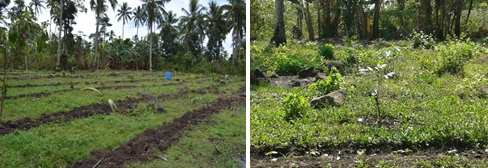

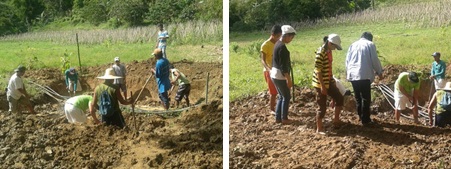
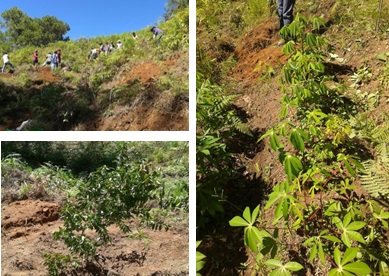
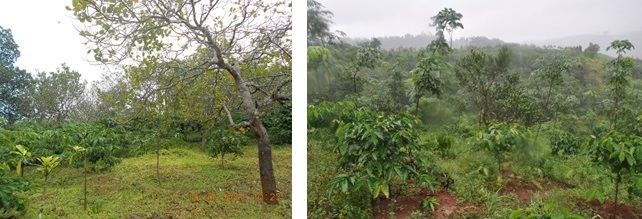
In Viet Nam, the ALL was established in Bu Nor Vilalge in Quang Tam commune, Tuy Duc District, Dak Nong Province in the Central Highlands of Vietnam. The ALL was mainly hilly area with an elevation of 700-1000 masl and 15-200 slope. The mean annual rainfall is 2400 mm, with a dry season of three months, and mean
annual temperature of 22.20C. The area is being maintained by the M-Nong indigenous people. The ALLs is characterized with paddy rice, shifting cultivation area,
integrated with rubber, coffee and cashew (Figure 5). The Vietnam team formed a Board to manage the ALLS which consist of 14 key farmers, 2 staff of the commune and two staff of district. New cultivation models that are adaptive to climate change were integrated in the ALLs, including the planting of high quality avocado, coffee and annual crops, and cow production as well.
In Indonesia, the goat farm was established as a demonstration site to increase the income of the farmers in Gabungan Kelompok Tani of Wana Tani Lestari, Talang Jakarta, Pekon Datar Lebuay, Tanggamus District (Figure 6). Establishment of the goat farm is also seen as a climate change adaptation strategy in the region because of the high potential of forage/grasses from state forests and clan forests. The farmers can likewise produce organic fertilizers from the goat manure, which can be used in their crop production activities. Aquasilviculture is another agroforestry system that was established as a climate change adaptation strategy. The gurame fish aquaculture was introduced to the members of the Gapoktan community in Sumber Bandung Village, Subdistrict of Pagelaran Utara, Pringsewu District to lessen the dependence of the farmers to the forest areas particularly in Register 22 Way Waya (Figure 7). Activities of Agrosilvofishery held by INAFE-UNILA around the management area of Unit Pengelola Teknis Daerah (UPTD) KPH Batutegi especially with Gapoktan Sumber Makmur become one alternative in order to raise the community’s income by helping Gurame fish Aquaculture. Availability of water resources and the natural food of gurame that is kajer/tales species would be more beneficial if used by making it as gurame aquaculture.

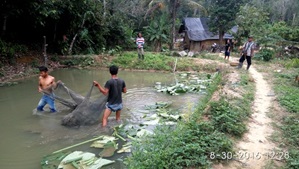
These cropping combinations fall under the farming system, agroforestry. Agroforestry is a dynamic, ecologically-based natural resource management system that deliberately combines woody perennials with herbaceous crops and/or animals, either in some form of spatial arrangement or temporal sequence on the same land, with the aim of diversifying and sustaining production for increased social economic and environmental benefits (ICRAF, 2007; Lundgren & Raintree, 1983) [9] [7]. Lasco and Visco (2003) [6] also highlight that agroforestry has two or more species of plants at least one of which is a woody perennial, has two or more outputs; always longer than one cycle and has significant interactions between woody and non-woody components.
The practice of agroforestry among the upland farming communities was recommended by the project team because of the immense potentials of this land use system in climate change adaptation. In their study, Tolentino et al (2008) highlight the potentials of different agroforestry systems in carbon sequestration, ensuring food security, improving biological conditions, and improving farm income in the different provinces in the Philippines. Thus, they argue that agroforestry is a key climate change adaptation strategy because it provides multiple harvests at different times of the year, and the diverse combinations can help buffer its practitioners from the risk of income loss due to climate variability, price variability and other unanticipated problems. For instance, Beetz (2002) [2] points out that the resulting biological interactions provide a wide range of above-and below-ground opportunities and benefits including diversified income sources, increased biological production, better water quality and improved habitat for both human beings and wildlife. Cunningham et al (2008) [3] confirm that the range and rotation of high-performing annual crops provide income and reduce disease incidence. There is a shift from reliance on one or two annual crops to a range of food-and income-generating crops, thus, spreading risks and reducing vulnerability to environmental shocks. In addition, labor requirements and income are spread throughout the year.
Learning from other farmers’ experiences through cross-farm visits
Cross-farm visits were organized to expose the upland farmers to the different agroforestry practices and climate change adaptation strategies that are being employed by other farmers in nearby communities, which could possibly be applied in their own farms. Cross-farm visit was considered by the project team as a vehicle for promoting workable and appropriate farming techniques for climate change adaptation. In their study, Millar et al (2005) [8] argued that cross visits had the greatest impact on farmer awareness, farmer confidence and problem solving, and was the preferred methodology in learning about new technologies. They added that cross-farm visits offers opportunities for farmers to see the real situation in the field; talk and discuss with their fellow farmers; share experiences and lessons directly; remember the activities much better when they have seen them in the field; and, can easily apply what they have seen back in their own village.
Three cross-farm visits were organized in the Philippines. The farmers from Nueva Vizcaya province visited the agroforestry farms in Vista Hills, Bayombong, Nueva Vizcaya on January 16, 2016 while those from Benguet province have visited the agroforestry farms with organic farming practices in Wangal, La Trinidad, Benguet on May 13, 2016. On June 17, 2016, the farmers from Quezon province visited the agroforestry farms in Silang, Cavite, which specifically showcase the 1:9 agroforestry system.
In Indonesia, 12 farmers from the CF Subgroup in Batu Tegi KPH conducted their cross-farm visits on March 12-13, 2016 in West Lampung District. During the visit, the head of the groups discussed with BW and KWT Melati groups, and then visited and observed the coffee plantation and processing. In Vietnam, 12 participants, including 10 key farmers and 2 staff members attended the June, 2016, a cross farm visit that was organized by the Tay Nguyen University. The visit was held in the neighboring villages in Quang Tan and Quang Tam Communes, Tuy Duc Distgrict.
References
- [1] Afzal, S. K. (1995). Wheat growers’ exposure and adoptability of new technologies through extension service in FR Bannu. M.Sc (H) Thesis, NWFP Agricultural University Peshawar.
- [2] Beetz, A. (2002). Agroforestry: An overview. National Sustainable Agriculture Information Service. Retrieved from https://attra.ncat.org/wp-content/uploads/2019/05/agrofor.pdf?
- [3] Cunningham, P.J., Nicholson, C., Yaou, S. and Rinaudo, T. (2008). Utilization of Australian acacias for improving food security and environmental sustainability in the Sahel, West Africa. In Proceedings of the International Symposium on Underutilized Plants for Food, Nutrition, Income and Sustainable Development. Arusha, Tanzania, 3-7 March 2008. Retrieved from http://www.icuc-iwmi.org/Symposium2008/
- [4] Davies, M., Oswald, K. and Mitchell, T. (2009). Climate change adaptation, disaster risk reduction and social protection. Retrieved from https://www.oecd.org/dac/povertyreduction/43280946.pdf
- [5] Khan, C. A., Pervaiz, U., Khan, N. M., Ahmad, S. and Nigar, S. (2009). Effectiveness of demonstration plots as extension method adopted by AKRSP for agricultural technology dissemination in District Chitral. Sarhad Journal of Agriculture, 25(2). Retrieved from www.aup.edu.pk/sj_pdf/EFFECTIVENESS%20OF%20DEMONSTRATION%20PLOTS%20AS%20EXTENSION.PDF
- [6] Lasco, R. D. and Visco, R. G. (2003). Introduction to Agroforestry: A Lecture Syllabus. University of the Philippines Los Baños, College, Laguna, Philippines
- [7] Lundgren, B.O. and Raintree, J.B. (1983). Sustained agro-forestry. In B. Nestal (ed.) Agricultural Research for Development: Potentials and Challenges in Asia. The Hague: ISNAR.
- [8] Millar, J., Photakoun, V. and Connet, J. (2005). Scaling out impacts: A study of three methods for introducing forage technologies to villages in Lao PDR. Retrieved from http://ageconsearch.umn.edu/bitstream/118372/2/WP58-body.pdf
- [9] ICRAF. (2007). Feature essay tackling global challenges through agroforestry. Annual Report for 2006. World Agroforestry Centre (ICRAF). Nairobi, Kenya. Retrieved from www.worldagroforestry.org/ar2006/feature_essay_5.asp
